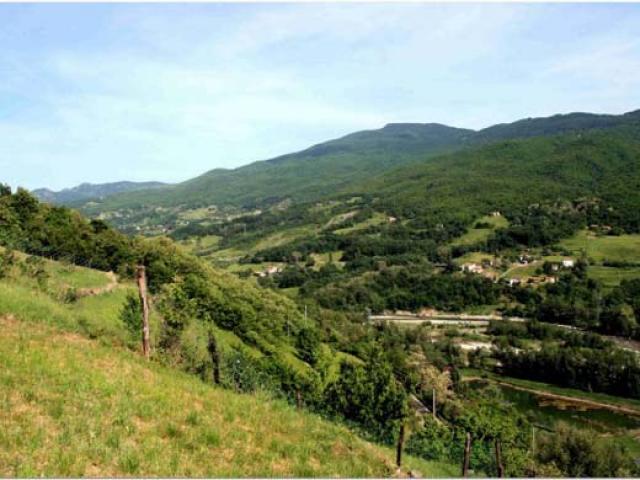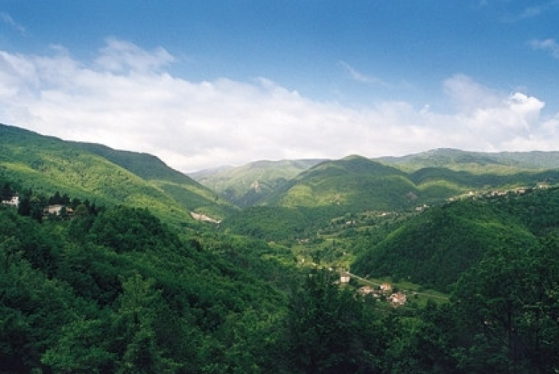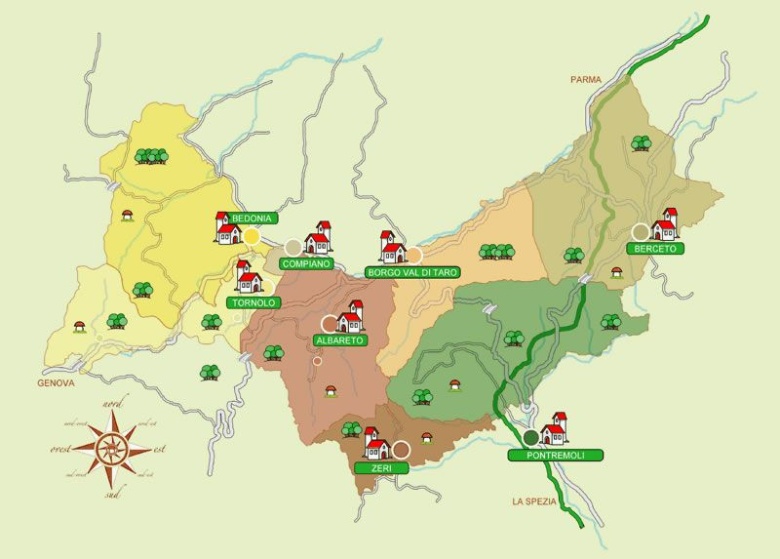
Riserva Mab Unesco e il Sentiero dei Castagni
This post is also available in:
 Italiano (Italian)
Italiano (Italian)
On the Parma’s Apennines, in Val Taro, there is Riserva Mab, which was instituted by Unesco in 2015 and represents a typical condition of the mountain-apennine territory characterised by being a meeting point of the climatic Euro-Mediterranean area. This characteristic has determined together with the geologic inheritance and other factors, such as the development of a complex cultural-ecological mosaic, which is the base for the evolution of the landscape. It has an extension of 223.229 hectares and includes 34 municipalities.
- In the province of Reggio Emilia: Baiso, Canossa, Carpineti, Casina, Castelnovo ne’ Monti*, Toano, Ventasso*, Vetto, Vezzano sul Crostolo, Villa Minozzo*
- In the province of Parma: Berceto, Calestano, Corniglio*, Langhirano, Lesignano de Bagni, Monchio delle Corti*, Neviano degli Arduini, Palanzano, Tizzano Val Parma
- In the province of Modena: Frassinoro
- In the province of Massa Carrara: Bagnone*, Casola in Lunigiana, Comano*, Filattiera*, Fivizzano*, Fosdinovo, Licciana Nardi*, Villafranca in Lunigiana
- In the province of Lucca: Castelnuovo Garfagnana, Piazza al Serchio, Pieve Fosciana, San Romano in Garfagnana*, Sillano Giuncugnano*, Villa Collemandina*
The reserve is mainly occupied by forests (beech tree, oak and chestnut tree woods), cultivations (fodders, olive tree groves, vine yards, cereals) and pastures. There is more than 70% of Italian biodiversity, with some emergencies such us Apennines primroses, wolfs, golden eagles. There are more than 2000 species, of which 122, between birds, amphibious, reptiles, mammals, fishes and invertebrates.
In Berceto, ancient borgo made of stone and belonging to Associazone Antichi Borghi d’Italia, surrounded by the vegetation of the valley of the Manubiola stream, there is a sustainable farm holiday and restaurant Il Bacher, specialised in dishes made with local products. It is part of the club di Prodotto Parma City of Gastronomy and in its menu there are different presidium Slow Food. It uses only their vegetables and fruits, which are from biological cultivations, wild berries and mushrooms. In addition, it organises excursion for the recognition of mushrooms in Autumn.
In the riserve, it is possible to make numerous excursions on foot and by bike, in the consortium woods, with regular permissions to collect porcini of Val Taro: here it is possible to collect Fungo Porcino IGP, the only certified one in all Europe, and slow-food presidium. The mark has been obtained in 1993 by the Ministry and in 1996 by CEE. In the area passes also a part of the Francigena Road.
During the walks, it is possible to meet the marvellous wild fauna of the reserve. There are roe deers, fallow deers, badgers, foxes, boars, squirrels and birds of every species, which are surrounded by thousand of-year old forests, mainly chestnut tree woods, in an uncontaminated nature.
Berceto. Its position on the Francigena road, is one of the most important commercial communication routes, and made Berceto a strategic place at the end of the Middle Ages. Their origins date back to the 8th century: the lombardic king Liutprando had a monastery built in the valley and as time went on the community around it became wider and wider. It was important for religion, in 879 was handed down to the Bishop of Parma. In the 12th century became a property of the municipality of Parma and, from 1308 till 1666, was a feud of the Rossi family, who carefully embellished the Borgo.
Il Sentiero dei Castagni. From Borgo Val di Taro starts a route which arrives till the groupings of stone houses of Vighini and Carlinetti, between marvellous woods of chestnut trees fed by streams, springs and peat bogs. From the station of Borgotaro it is possible to take the provincial road of Passo del Bratello, then turn left to go to the town of Grifola. From here on, it is possible to travel on the council road till borgo dei Vighini. There is also the possibility to travel on till the peat bog Orsaresso, living the pedestrian road between Vighini and Carlinetti, entering in the wood along the path (Cai 833 D), which coasts an abandoned chestnut tree wood, and keeps on going between forests of chestnut trees, crosses Rio Orsaresso, which feeds the peat bog by the same name, then coasts a small pine wood of spruces, silver firs and firs in the valley of Ghierma, to reach Prato Zuccone, a partially underground peat bog. From Prato Zuccone the path goes on and keeps on coasting the small pine wood till crossing Rio del Burallo and other streams to get to the ancient farmsteads of Pian del Lago, 770 meters of altitude. From here on the path goes back to Prato di Orsaresso, and goes on till Carlineti, which is near the starting point.
This post is also available in:
 Italiano (Italian)
Italiano (Italian)
Contatti
Borgo Val Taro e altre (PR)(PR)
0522/610551 oppure 0585/947200
biosfera@parcoappennino.it




